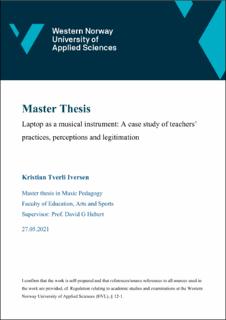| dc.description.abstract | During the past decade, the laptop has been offered at an increasing number of Norwegian upper secondary schools. It is without a doubt the instrument with the fewest similarities to the remaining instruments, which offers fascinating challenges and opportunities. The empirical data is based on five laptop teachers who are comparatively analysed (Yin, 2018), and differences and similarities between their teaching practices form the results chapter of the thesis. The empirical data is based on one semi-structured interview (2-3 hours) per teacher and observation of one-toone lessons in laptop, in addition to observation of a school concert and a band lesson with a laptop student. Due to the Covid-19 pandemic, two interviews and one observation were conducted via Zoom. In addition, triangulation (Stake, 1995) through external opinion bearers and a YouTube-analysis was used to discuss points in the data material. Through the discussion through Bell's (2015a) five prong affordance-theory, findings portray the laptop's central affordances in performance are related to recording, programming, processing, “playback”, digital synthesis, sampling and looping. Findings express that the laptop in live performance can be used "in a hundred ways" (Øyvind), in addition to many approaches to music creation (programming, recording), also musical ideas can be achieved through multiple approaches. On the other hand, there seems to be an agreement that active live approaches of "Live Processing", "Live Looping" or "Live Sampling" are viewed as good performance goals. Data portraits multiple challenges when using laptop in bands alongside "traditional instruments”. Challenges such as live setup with MIDI-controllers, role in the group, and approach to performance are central elements. An important point is who should be the “time-keeper" in the group, and data portrays different approaches and considerations with both the laptop as the time-keeper and the human as the time-keeper. Through informal structures in combination with the recent formalisation, additionally the explorative nature of sound design and audio processing, there are strong democratic elements in the teaching practices. The teachers mostly experience that the formalisation of the laptop has been well received, however, there are certain misunderstandings about how broad the laptops’ affordances are and the many approaches to live performance. | en_US |

